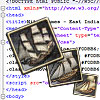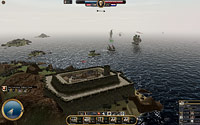- Overviews
- East India Company
- Pirate Bay
- Privateer
- Designer's Cut
- Battle of Trafalgar
- Collection
- Ship Introductions
- Designer's Blog
- Developer's Video Diary
- Modding Instructions-series
 9th October 2009:
9th October 2009:Modding part 6.
This time we learn how to translate the East India Company to your own language.
Read more » 15th July 2009:
15th July 2009:Naval warfare, part II.
Lead designer Kim Soares takes the helm of a frigate and shouts: "Port side, FIRE!"
Read more »
 Keep yourself posted on the latest news about East India Company.
Keep yourself posted on the latest news about East India Company.
Email-address:
 Sign up for the Paradox newsletter, and get all the news directly from Paradox Interactive.
Sign up for the Paradox newsletter, and get all the news directly from Paradox Interactive.
Email-address:


Designer's Blog: Collection of arbitrary rules
How can a bunch of rules create something fun?
One of the many things that intrigue me about games is the fact of what they essentially are: a collection of arbitrary rules bound together by logic. How this creates something that people find fun and enjoyable never ceases to make me wonder.

Monopoly is boardgame everyone knows. Next time when you play it, stop to think about the kind of rules it has and what would happen if you altered them. Monopoly uses six-sided die. What if it used an 8-sided one instead? Or 20-sided?
Why does Monopoly use six-sided die? Probably because when Charles Darrow designed the game in 1935, that was the most common die. And why was six-sided die the most common? Because dice were originally, some 5000 years ago, made from the ankle bones of hoofed animals. Those bones happened to be tetrahedral in shape.

Everything affects something else
Games, as simple as board games, can be "tuned" easily with house rules or the equivalent. Video games have so many rules and internal dependencies that changing even one simple thing can have very far flung effects. Lately I have been playing a lot of Fallout 3, which is one of the greatest games this year. Stimpack that replenishes lost hit points costs about 40 caps in Fallout 3.
Big deal? The devs probably just came up with that number? What would happen, if the price was, say, tripled? Players could not afford as many stimpacks. It would make the whole game harder. Players would have to resort to food and drink to get hit points back.
But, as all food and drink are contaminated with radiation, that would result in radiation levels rising too fast. To counter that, effects of radiation could be toned down. But toning down effects of radiation would in turn make radioactive weapons and hazards less dangerous. You probably get my point.

Build time for ships
In East India Company, we have been busy applying the last gameplay elements. One of the major ones was building time for all ships. It is a simple thing as such, but affects many elements and balance of the whole game. In effect, all ships require some time to build.
Players are no longer able to just churn out ships even if they have money. This makes shipyards a lot more important, as now the size of your fleet greatly depends on your access to shipyards and their ability to build ships.
Building time for ships also means that there is always a delay after your decision, so you should try and think beforehand about when you will need more ships.
I'm really happy about how building time for ships seems to affect the gameplay and gives players more choices on tactics. Naturally, it has to be extensively tested and our testing department is digging into it as I'm writing this. Until next time!
Kim Soares







